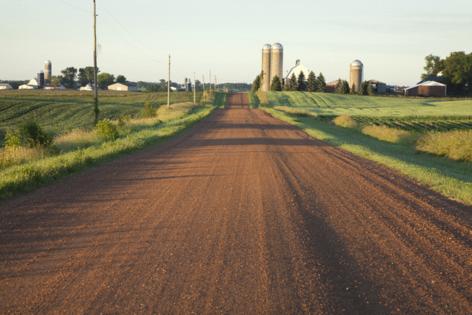Dennis Anderson: Stop mowing roadsides and hurting our wildlife
Published in Outdoors
MINNEAPOLIS — Todd Finkelson suffers from road rage, though not the kind that typically makes headlines.
Every day, when he drives from his home near Ashby in west-central Minnesota to Fergus Falls, where he works, he keeps a sharp eye on the road — and an even sharper eye on roadsides.
“In that short distance, I can count at least 10 roadsides that have been mowed by farmers or landowners,” Finkelson said. “A lot of the mowing isn’t even for the hay. It’s for cosmetics. They mow just because they think it looks good. All at the expense of wildlife.”
Fifteen-foot safety zones are routinely, and legally, mowed alongside most Minnesota roads. But full-width mowings of the type Finkelson describes occur every summer across Minnesota, sometimes in violation of state law that limits roadside mowing before Aug. 1.
Wildlife suffers in the process, particularly when grasses and other vegetation are cut nearly to the ground, destroying habitat that nurtures insects as well as wildlife.
And if equipment isn’t cleaned after each mowing, Canada thistle and other weeds can be spread.
Sometimes, as Finkelson notes, mowing is done simply to make roadsides appear lawn-like. Other times, farmers mow roadsides for hay to feed livestock or sell.
Lost are some of the estimated 500,000 acres of Minnesota wildlife cover that border most Minnesota roads. Gone as well, in many instances, are milkweed and other plants needed to sustain pollinators such as monarch butterflies, which are listed as threatened by the U.S. Fish and Wildlife Service.
Delaying mowing until Aug. 1 allows young birds a chance to hatch and move to safer cover, wildlife advocates say. But the restriction is routinely violated and virtually never enforced.
“We request that farmers get permits from us to mow roadsides,” said Tina Markeson, Minnesota Department of Transportation roadside vegetation management supervisor. “But starting in June, some mowing occurs without permits. There hasn’t been a great answer about how we control this.”
Roadside management for wildlife has been a priority among Minnesota conservationists since at least 1983.
That’s when Pheasants Forever was founded in St. Paul (disclosure: I was the group’s principal founder) with three initial goals: to enact a pheasant stamp required of adult ringneck hunters; to pass a state law requiring that roadside mowing (except for safety considerations) be delayed until Aug. 1; and to use a portion of pheasant stamp funds to hire a Department of Natural Resources roadside wildlife coordinator, a first for the agency.
The Legislature approved the pheasant stamp in 1983; the mowing restriction was enacted in 1985.
Iowa wildlife biologist Ken Varland moved to southern Minnesota to take the new roadside job in 1984.
“Our objectives were to make people more aware of roadsides as important wildlife habitat, to reduce disturbance of roadsides and to manage roadsides through improved seeding,” said Varland, who retired from the DNR in 2015 as a regional wildlife manager.
Varland said he attempted to educate state, county and township road officials about the potential financial savings and wildlife benefits of reducing unnecessary mowing.
“We made some progress,” he said. “The problem was — and is — that roadside management is a political nightmare because farmers and other landowners have been mowing roadsides for so long they feel it’s their right."
The DNR no longer employs a roadside wildlife coordinator, said the agency’s prairie program leader.
“It’s been a defunct program for quite a few years,” Greg Hoch said. “I can’t remember when we formally ended it, and even before that, it was a program in name only.”
As recently as 2016, the DNR and a bipartisan group of legislators attempted to resurrect roadside management as an important conservation tool. Two years earlier, Gov. Mark Dayton had convened a Pheasant Summit in Marshall to explore ways to increase farmland wildlife populations. Improving roadside management was identified as a priority.
But legislators, primarily from Greater Minnesota, passed a moratorium that restricted MnDOT from enforcing certain highway roadside mowing regulations, and under the administration of Gov. Tim Walz, the state’s roadsides for wildlife effort has largely gone dormant.
Not all news is bad. Though mowing along county and township roads is often unregulated, MnDOT delays until September most of its large-scale mowing along the approximately 10% of state roadways it manages.
“That’s part of the conservation measures we’ve agreed to with the Fish and Wildlife Service to protect milkweed and other forage species that help monarch butterflies," Markeson said.
MnDOT also routinely plants native species at its construction sites. And under Dan Gullickson, the agency has a living snow fence program that sometimes pays farmers to leave standing corn on their property edges.
“To help with snow control, we also plant shrubs that are good for wildlife,” Gullickson said.
Since its founding, Pheasants Forever and its companion group Quail Forever have grown to 165,000 members. The groups employ wildlife biologist Mike Letterer, whose focus is roadside wildlife management nationwide.
“We believe most roadsides can be managed sustainably and more cost-effectively than they currently are,” said Letterer, who’s stationed in Ohio.
Practices adopted by MnDOT and highway agencies in other states that benefit monarch butterflies as well as certain bee species also benefit pheasants and other wildlife, Letterer said.
In many instances, farmers who want to mow roadsides can be accommodated in the process.
“There are certain ‘windows of time’ when mowing can be done that doesn’t harm wildlife,” Letterer said. “What we call ‘conservation mowing’ also recommends that mowers are set to leave 12 to 18 inches of cover, rather than mowing right to the ground. That will save a place for wildlife, while also keeping insects around that birds need to eat.”
Spot spraying of herbicides to control roadside weeds and invasive plants is also recommended, Letterer said, rather than broadcast spraying, which is more expensive and often kills good plants along with bad ones.
Finkelson said his trips to work and back would be less stressful if he saw more roadsides that were wildlife-friendly.
“We’ve got to stop taking, taking and taking from wildlife,” he said. “At some point, we need to give back.”
____
©2025 The Minnesota Star Tribune. Visit startribune.com. Distributed by Tribune Content Agency, LLC







Comments